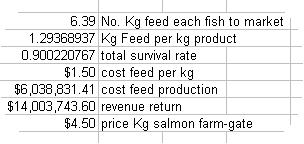Little Hawk
Active Member
Good point Agent. He'll shoot himself in the foot just fine on his own...
Regarding the methodology of likening or quantifying salmon farming pollution to a human sewage equivalent, I don't know why some of you seem to take issue with that; it's simply a different perspective.
We all know how pissed many people are that Victoria still pumps all it's **** directly into the Juan de Fuca. Well when I first read that data comparing the pollution output of your average fish-farm to that of the raw-sewage equivalent of a city of 500,000 people... then multiplied it by what... 125 active farms, the fact that it also had lots of water mixed in with it soon became a moot point to me.
Think about it.
The Norwegian salmon farmers are making money hand over foot in our water. About a thousand or so folks in BC's more remote communities have a medial paying job thanks to the industry and a few collusive politicians are also getting their pockets greased.
But what does the average Joe British Columbian like you and me get out of it?
1) Catastrophic disease & parasite transfer to our beloved Wild Pacific Salmon, some of which (sea-lice) has already been shown to be killing them by the millions. Remember the other big-ones, the viruses (ISA ect) haven't broke out yet... YET!
2) A foreign owned industry licensed by our own government to dump unspeakably-horrific amounts of toxic-waste directly into many of our most beautiful and pristine marine waterways, twenty-four hours a day... seven-days a week.(If you or I took a dump then pumped it out while tied-up at a marina, the Coast Guard would fine you in a heartbeat!) But this is okay. As long as they're not set up in the Howe Sound, Burrard Inlet or here on the South Island and remain out-of-sight of 95% of BC's tourists' - who cares?
3) A steady stream of escaping alien fish (Atlantic Salmon) that have shown us they have the capacity to colonize our waterways and compete with Pacific Salmon and Steelhead for both food and habitat resources.
And regardless that even the most seasoned scientific industry-apologists will concede that colonization is not impossible, they are all quick to point out that it has not happened yet... YET!
4) An industry that appears to have successfully convinced (paid-off) enough people in high-places (Campbell & Harper) that Canada needs not to worry about investing crucial resources in the welfare & rehabilitation of Pacific Salmon because they - 'Our Saviors' - are here to grow all the toxic-fish us pig-headed North Americans' will ever need.
Any more "Top-rods" on this forum want to chime-in in defense of this catastrophe-in-the-works?
Me, I'm not leaving 'rubber-fish' for my kids!
Regarding the methodology of likening or quantifying salmon farming pollution to a human sewage equivalent, I don't know why some of you seem to take issue with that; it's simply a different perspective.
We all know how pissed many people are that Victoria still pumps all it's **** directly into the Juan de Fuca. Well when I first read that data comparing the pollution output of your average fish-farm to that of the raw-sewage equivalent of a city of 500,000 people... then multiplied it by what... 125 active farms, the fact that it also had lots of water mixed in with it soon became a moot point to me.
Think about it.
The Norwegian salmon farmers are making money hand over foot in our water. About a thousand or so folks in BC's more remote communities have a medial paying job thanks to the industry and a few collusive politicians are also getting their pockets greased.
But what does the average Joe British Columbian like you and me get out of it?
1) Catastrophic disease & parasite transfer to our beloved Wild Pacific Salmon, some of which (sea-lice) has already been shown to be killing them by the millions. Remember the other big-ones, the viruses (ISA ect) haven't broke out yet... YET!
2) A foreign owned industry licensed by our own government to dump unspeakably-horrific amounts of toxic-waste directly into many of our most beautiful and pristine marine waterways, twenty-four hours a day... seven-days a week.(If you or I took a dump then pumped it out while tied-up at a marina, the Coast Guard would fine you in a heartbeat!) But this is okay. As long as they're not set up in the Howe Sound, Burrard Inlet or here on the South Island and remain out-of-sight of 95% of BC's tourists' - who cares?
3) A steady stream of escaping alien fish (Atlantic Salmon) that have shown us they have the capacity to colonize our waterways and compete with Pacific Salmon and Steelhead for both food and habitat resources.
And regardless that even the most seasoned scientific industry-apologists will concede that colonization is not impossible, they are all quick to point out that it has not happened yet... YET!
4) An industry that appears to have successfully convinced (paid-off) enough people in high-places (Campbell & Harper) that Canada needs not to worry about investing crucial resources in the welfare & rehabilitation of Pacific Salmon because they - 'Our Saviors' - are here to grow all the toxic-fish us pig-headed North Americans' will ever need.
Any more "Top-rods" on this forum want to chime-in in defense of this catastrophe-in-the-works?
Me, I'm not leaving 'rubber-fish' for my kids!





